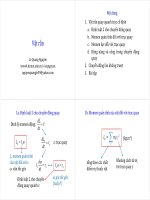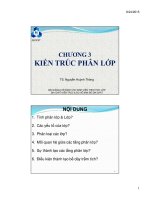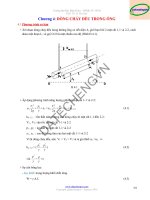Giao trinh bai tap english for students of physics – vol 1
Bạn đang xem bản rút gọn của tài liệu. Xem và tải ngay bản đầy đủ của tài liệu tại đây (448.59 KB, 4 trang )
Transformers – Introduction
Transferring electrical energy from one circuit to another through
time-varying magnetic field.
ECE430
Applications: both power and communications fields.
In transmission, distribution, and utilization of electrical energy: step-
Power Circuits and Electromechanics
up or step-down voltages at a fixed frequency (50/60 Hz), at power of
hundreds of watts to hundreds of megawatts.
Dr. Nam Nguyen-Quang
Fall 2009
In communications, transformers can be used for impedance
matching, DC isolation, and changing voltage levels at power of a few
watts over a very wide frequency range.
/>
This course concerns only power transformers.
Lecture 4
1
Ideal transformer
i1
wound as shown. Ignore losses, stray
+
v1
–
capacitance, and leakage flux.
N1
i2
+
v2
–
N2
Magnetic permeability is infinite or zero
reluctance.
d
dt
2
Ideal transformer (cont.)
Consider a magnetic core with two coils
v1 t N 1
Lecture 4
v 2 t N 2
d
dt
v1 t N 1
a
v2 t N 2
v1 N1
a
v2 N2
i1
i1
N
1
2
i2
N1
a
i2
+
v1
v2
v1 t i1 t v2 t i2 t 0
–
v1 N1
a
v2 N 2
+
+
v1
v2
–
N1:N 2
i1
i1 N 2 1
i2 N 1 a
v1 t i1 t v 2 t i2 t
Ideal
i2
–
–
N1:N 2
a is called turns ratio.
Total mmf is given by
Ideal
+
It can be shown, for an ideal transformer
mmf N1i1 N 2 i2 R 0
i1 t
N
1
2
i2 t
N1
a
k 1
Lecture 4
L2
i1
v
1
2
i2
v1
a
L1
3
Impedance-changing property of ideal transformer
L1 N 22 L2 N 12
Lecture 4
4
Impedance matching
Consider an ideal transformer with resistive load accross winding 2
The impedance-changing property can be used for maximizing power
v2
RL
By Ohm’s law,
i2
Subsituting v2 v1 a and i2 ai1
transferring between to windings, or matching impedances.
i1
Ideal
+
2
i2
+
v1
v2
–
–
N
v1
a 2 R L 2 R L
i1
N1
RL
An ideal transformer is placed between power source (impedance Zo )
and load (impedance ZL). Turns ratio is so selected that
N1:N 2
Z o N 1 N 2 Z L
2
Ex. 3.7: Two ideal transformer (each of ratio 2:1) and one resistor R
are used to maximize power transfer. Find R.
The discussion can easily be extended to systems with complex load.
It can be verified that
V1 N 2
I 1 N 1
2
Load resistance 4 together with R referred to the input side is (R +
2
V2 N 2
Z L a 2 Z L
I 2 N1
Lecture 4
4(2)2)(2)2. For maximum power transfer,
10 4 R 64
5
R 13.5
Lecture 4
6
1
Power transformer
More pictures
Two windings mounted on a magnetic
core, minimizing leakage flux.
“Primary” winding (N1 turns) connected
to power supply, “secondary” winding (N2
Small power
turns) connected to load circuit.
Small 3-phase
Control
Cast resin
Assuming an ideal transformer: no leakage flux, winding resistances
are neglected, magnetic core has infinite permeability, and is lossless.
Let v1(t) = Vm1cost is the voltage applied to the primary winding, it can
be shown that
Vm1 2fN 1 max
or
V1 4.44 fN 1 max
Lecture 4
Example
110 kV, oil
10 kV, oil
7
500 kV, oil
Lecture 4
8
Equivalent circuit of transformer with linear core
Ex. 3.8: Given N1, N2, core cross-sectional area, mean core length, B-
Consider now a transformer with leakage flux and winding resistances.
H curve, and the applied voltage. Find maximum flux density, and
Equivalent directly derived from physical model is simple but somewhat useless.
required magnetizing current.
The equations on the secondary side is mulplied by a (= N1/N2) and i2 is replaced
V1 4.44 fN 1 max
max
Hence,
where
by i2/a, to derive a more useful equivalent circuit.
V1 230 V, f 60 Hz, N1 200
i1
230
4.32 10 3 webers
4.44 60 200
+
v1
L1 – aM
R1
i2
+
2
a2R2 a L2 – aM
+
RL
v2
+
i1
v1
aM
i2/a
av2
a2RL
4.32 10 3
Therefore,
Bm
0.864 webers/m 2
0.005
The required H m 0.864 300 259 At/m , the peak value of
L1 – aM is termed the leakage inductance of winding 1, a2L 2 – aM is termed
magnetizing current is (259)(0.5)/200 = 0.6475 A. Hence, Irms = 0.46 A is
“referred” (to side 1) leakage inductance of winding 2. aM is the magnetizing
–
–
–
N1:N 2
–
inductance, and its associated current is called magnetizing current.
the magnetizing on the primary side.
Lecture 4
9
Equivalent circuit of transformer with linear core (cont.)
Lecture 4
10
Transformer under sinusoidal steady-state conditions
There are losses in the magnetic core due to hysteresis and eddy current.
For steady-state operation, impedances and phasors can be used in
These losses are very difficult to calculate analytically. The sum of these losses
the equivalent circuit.
represents the total loss in the magnetic circuit of the transformer, and depends
+
be placed in parallel with the magnetizing inductance aM to account for them.
i1
R1
L1 – aM
2
a2R2 a L2 – aM
+
v1
V1
Ideal
+
Rc1
(aM)1
–
v2
–
–
I1
ja2xl2
I2 a
Rc1
jXm1
+
I2
+
aV 2
V2
–
–
Ideal
ZL
N1:N 2
where
RL
N1:N 2
Real load RL and its associated voltage and current can be retained by
L1 aM xl1 Leakage reactance of winding 1
aM X m1 Magnetizing reactance referred to winding 1
L2 M a xl 2 Leakage reactance of winding 2
a 2 L2 aM a 2 xl 2 Leakage reactance of winding 2 referred to side 1
referring them back to the secondary side, using an ideal transformer.
Lecture 4
a2R2
–
i2
+
av2
jxl1
R1
only upon the value of B m. They are called core or iron losses. A resistance can
11
Lecture 4
12
2
Transformer under steady-state (cont.)
Approximate equivalent circuit
All quantities can be referred to winding 1
jxl1
R1
+
Magnetizing branch makes computation somewhat difficult, hence this
a2R2
I1
branch is moved to the terminals of winding 1, yielding an approximate
ja2xl2
V1
Rc1
equivalent circuit, with no serious numerical error introduced.
+
I2 a
a2Z
jXm1
aV2
L
–
R1
+
–
ZL
jXm1/a 2
+
V2
–
I1
V1 Rc1
–
I2 a
jXm1
R1eq R1 a 2 R2
aV2
x1eq xl1 a 2 xl 2
–
13
Open- and short-circuit tests of transformers
+
a2ZL
–
Lecture 4
aV2
jx1eq
R1eq
+
I2
Rc1/a2
a2ZL
–
jxl2
R2
aI1
V1 a
+
I2 a
jXm1
–
jxl1/a2
R1/a2
+
ja2xl2
a2R2
I1
V1 Rc1
Or they can be referred to winding 2
jxl1
Lecture 4
14
Open-circuit test
Parameters in equivalent circuit can be determined by two simple
The test is performed with all instrumentation on the LV side with the
tests: open-circuit test and short-circuit test.
HV side being open-circuited. Rated voltage is applied to LV side. Voc,
In power transformers, the windings are called high-voltage (HV) and
Ioc, and Poc are measured with the meters.
low-voltage (LV) windings.
A
Rc
I oc
W
Voc
V oc
Hence,
IR
V
Rc
LV
IX
Voc2
Poc
IR
Voc
Rc
I oc I R I X
I oc
I X I oc2 I R2
Voc
V
X m oc
IX
Xm
HV
IR
IX
Rc
Rc and Xm are the values referred to the LV side.
Open-circuit test
Equivalent circuit
Lecture 4
15
Short-circuit test
Lecture 4
16
Example
All the instrumentation is on the HV side. Rated current is supplied to
Ex. 3.9: Given OC and SC tests’ readings. Find equivalent circuit
HV side. Vsc, Isc, and Psc are measured with the meters.
parameters referred to the HV side.
A
Xm
I sc
W
Req
From OC test
Xeq
Vsc
Vsc
Rc
220 2
50
2
I X 12 0.227 0.974 A
V
IR
968
Xm
220
0.227 A
968
220
225.9
0.974
From SC test
HV
Req
Psc
I sc2
Z eq
LV
V sc
I sc
Req
X eq Z eq2 Req2
Z eq
Req and Xeq are referred to the HV side.
Lecture 4
60
17 2
0.2076
15
0.882
17
X eq 0.882 2 0.2076 2 0.8576
17
Lecture 4
18
3
Efficiency and voltage regulation
In-class quiz
Efficiency is defined as the ratio of output power to input power.
Problem 3.22 and 3.23.
Pout
Pout
Pout
100%
100%
Pin Pout losses
Pout Pc Pi
Losses are copper loss Pc and iron losses Pi.
Alternatively, if input power is known,
Pin Pc Pi
100%
Pin
Voltage regulation is defined as
% voltage regulation
Vno load Vload
100%
Vload
Lecture 4
19
Lecture 4
20
4









